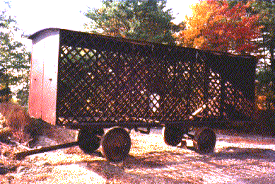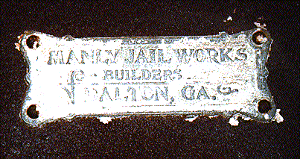AUGUST 22, 1996
RALEIGH - One of the few remaining turn of the century prison cages was moved from the
property of the Angus Barn restaurant to a Department of Correction warehouse Thursday to be
refurbished.
Owner of the Angus Barn, Van Eure has donated the 22 foot-long, six foot wide prison cage to the
Correction Department following its discovery behind the restaurant by a maintenance engineer
preparing to clear the area for a new parking lot. Gregg Aardal had seen the cage many times, but
not until he read a news article on prison cages did he suspect what it really was.
In the early part of this century, prisoners were hauled by two to four mules in 5,000 pound cages
from one road construction site to another building the North Carolina highway system. A dozen or
more inmates, chained together, slept three high in the confined space.

| A crane lifted the steel cage with its bradded
metal cross slats onto the back of a flatbed truck.
Inmates from Wake Correctional Center will help
refurbish the cage so that it may be displayed
possibly with other prison artifacts for the public
to see. "The historic value of this prison cage is
tremendous in reminding the public of the
deplorable conditions inflicted on man just
decades ago," Correction Secretary Franklin
Freeman said. "We thank Van Eure and the
Angus Barn for making this significant
contribution."
|
Only two other prison cages are known to exist in the state, one located at the Alexander
Correctional Center in Taylorsville and one at the Yadkin Correctional Center in Yadkinville. the
Alexander cage still has its original enamel toilet, while the Yadkin cage has a hitch and wheels.

| 
|
prison cage at Alexander Correctional Center
| prison cage at Yadkin Correctional Center
|
| Owners of Manly Jail Works of Dalton, Georgia,
have the original advertisements and blue prints of
the cage. One ad read: A bucket of disinfectant
once or twice a month and a bucket of paint once
a year will keep this cage clean, sanitary and
vermin-proof. |  |
Cages sold for about $500. A heavy, water-proof canvas was dropped over the sides for warmth
at night along with a wood heater fueled by the inmates.
Julian S. Mann, superintendent of prison from 1900 to 1909, said that the problems of neglect and
cruelty were serious and that North Carolina's chain gang policy could not be defended and should
be discontinued immediately. Life expectancy of the prisoners reportedly averaged five years. Not
until 1933, when the General Assembly authorized the construction of 100-man road camps in
each county did the state discontinue the use of prison cages.
"The restoration of this prison cage will be a stark reminder of how far penology has come in this
century and how much further we have to go," Freeman said.
-pmc-
History of the North Carolina Prison System



